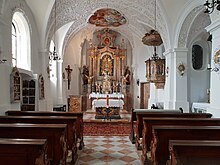Holy water
Heiligwasser is a place of pilgrimage near Innsbruck in Tyrol .
location
Heiligwasser lies at 1234 m above sea level. A. above Igls on the slope of the Patscherkofel . From Igls, a pilgrimage route with ten, now five chapels with representations of the joyous rosary leads up. Heiligwasser was also accessible from the middle station of the same name on the old Patscherkofelbahn .
history
According to legend, in 1606 Our Lady appeared to two peasant sons who were looking for lost cattle. She showed them the way to a spring where they could find the cattle and told them to tell the Canons of Wilten Abbey that a chapel should be built next to the spring. However, the boys did not dare to pass it on. When a deaf and dumb child was healed at the same spring in 1651, a small wooden chapel was built with the permission of the Bishop of Brixen, which soon became a destination for pilgrims. In 1661 Abbot Dominikus Löhr had the church that still exists today built, in which a Gothic Madonna from Wilten Abbey was erected in 1662 and the first mass was celebrated. On October 20, 1665 the church was consecrated to the patronage of Maria Schnee . At that time there was also a hermitage in Heiligwasser .
In 1723 a side chapel in honor of d. St. Ottilie added, in 1740/41 the church was extended by a porch yoke with a gallery. In the course of the reforms of Joseph II , the church was supposed to be closed in 1786, which could be prevented by a certificate confirming the healing properties of the spring water there. The pilgrimage was nevertheless severely restricted at the end of the 18th century. It flourished again in the 19th century, for the 250th anniversary in 1856, 30,000 pilgrims visited Heiligwasser during the festival week.
Pilgrimage church
The church, built between 1662 and 1665, is a simple rectangular hall building with a vestibule, a choir closed on three sides and a hexagonal choir tower with an onion helmet . Above the portal is a fresco from 1743 depicting the legend of the origin, which is attributed to Johann Michael Strickner . The interior of the three-bay nave is provided with pillars and a richly stucco cap barrel. The ceiling frescoes were created in 1945 by Hans Andre . On the baroque high altar is the miraculous image, a late Gothic Madonna and Child from the first half of the 15th century, which was stolen in 1971 and replaced by a copy. In the side chapel is a marble altar, which was donated in 1667 for the Annenkapelle of the collegiate church Wilten and with an altar leaf with the St. Ottilie from the 18th century.
Next to the main entrance in the west is the fountain built in 1736. To the east of the church is the pilgrimage inn, which was built under Abbot Martin Stickler (1719–1747) as a sacristan's house and was expanded to its present size in the 1920s.
literature
- Inge Dollinger: Tyrolean pilgrimage book. The pilgrimage sites in North, East and South Tyrol . Tyrolia - Athesia, Innsbruck - Bozen 1982, ISBN 3-7022-1442-9 , p. 21-23 .
- Schneider, Wiesauer: pilgrimage church Maria Schnee in Heiligwasser, pilgrimage chapel Heiligwasser hl. Ottilie. In: Tyrolean art register . Retrieved August 16, 2014 .
- 350 years of consecration Heiligwasser. In: Stift Wilten aktuell, issue 1/2015, pp. 12–13 ( digital version )
Web links
- Heiligwasser pilgrimage church , Wilten Abbey
Coordinates: 47 ° 13 ′ 0 ″ N , 11 ° 25 ′ 50 ″ E




